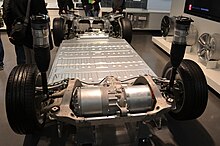Platform chassis
It is distinguished from other forms of chassis by being arranged as largely a single flat steel sheet, usually with additional box section stiffeners.
Although both body and platform chassis are each made from similar pressed steel panels welded together, they were often bolted as the final two units and so may still be separable after construction.
Achieving sufficient rigidity is difficult with a pure platform and so they are usually extended vertically with some form of box or tube section.
The diaphragm sheet is usually pressed into shallow stiffening ridges as well, but these are mostly to stop drumming noise and are too minor to provide major structural strength.
However they keep the engine at the driven end, with a transaxle, rather than using the propeller shaft of the Hotchkiss layout of front-engine, rear-drive that was universal with chassis designs beforehand.
This basic design proceeded through the pre-war Porsche Type 60, and several wartime military vehicles, before finally the first post-war mass-production Volkswagen Beetles of 1945.
These were slow-speed competitions across off-road terrain and obstacles, which developed both driving skill and vehicle agility, in ways which were expected to be useful for military motoring.
[4] Porsche continued to develop the Type 62 with such features as a rear portal axle to give increased ground clearance and the ability to move with infantry at a walking pace.
The rounded bodywork was also replaced with ribbed flat panels, with doors,[i] and by the end of 1939 this had been accepted as the military Type 82 Kübelwagen.
[9] These torsion bars were stacks of flat strips, and the number of leaves was changed to vary the suspension stiffness, over the production of the Beetle.
[10] An advantage for the production of the vehicle was that controls such as the driver's pedals and brake piping, the gear stick and the handbrake which required connections to the engine or drive train could be installed onto the platform before the body was added.
This made the front end vertically stiffer and the suspension was replaced by one based on Chevrolet parts, although still with double trailing arms.
The pack weight for a Tesla S is 1,200 pounds (540 kg)[14] As these are composed of 7,104 cells, packaged into 16 modules,[15] their overall shape is flexible and can be adjusted to best fit the vehicle.
Such armoured vehicles require all-wheel drive for off-road capacity with their weight, which many involve six or eight wheels, and so have often used a H-drive layout for the drivetrain.
Rather than axles connected by a central propeller shaft, the two sides are linked fore-and-aft by driveshafts in the lower corners of the punt.





